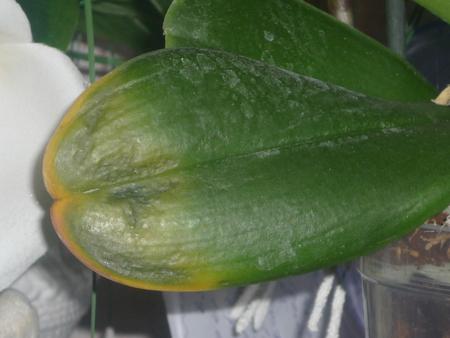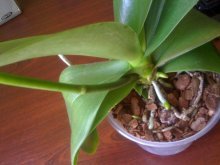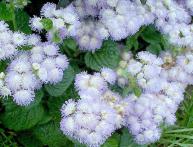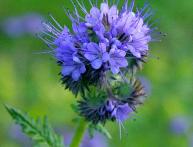Useful tips on what to do if your orchid withers

The most popular flower among indoor plant lovers is the orchid. The flowers come in a variety of colors and will perfectly decorate any interior at any time of the year.
When breeding orchids at home, the plant needs careful care.
Many indoor plant lovers face various problems when caring for orchids. The most common problem is flower wilting.
Content:
Why do orchid leaves turn yellow and wither?
There are many reasons why an orchid's leaves fade. After purchasing an orchid, after some time the plant begins to wither leaves.
This is due to the fact that the growing conditions do not meet the requirements of the plant. The main reasons for orchid wilting:
- insufficient lighting
- exposure to other plants
- lack or excess of nutrients
- excess moisture
- natural shedding of leaves
- overheating of the root system
The orchid is a heat-loving plant, so it needs good lighting. The flower feels great in bright, diffused rays.

If the orchid is located in a shaded place or is exposed to direct sunlight, this can also cause the plant to wilt. In this case, the orchid does not have enough lighting.
If the plant is located next to peperomia, yucca, cordilina, then the influence of these plants negatively affects the condition of the orchid. Therefore, it is not recommended to place an orchid next to the above plants.
The leaves of the plant may turn yellow if there is a shortage or excess fertilizers. When choosing a fertilizer, you should pay attention to the composition.
If the fertilizer contains a low potassium content, the orchid's leaves first become pale, then acquire a yellow tint. As a result, they dry out and begin to fall off.
Plant nutrition should be chosen that contains iron and potassium, since these elements are the most necessary for the development of the plant.
Excess moisture may cause the plant to wilt. The roots of plants must be constantly monitored so that they do not rot.
If the leaves become limp and yellowish, but the general condition of the plant has not changed, then they may fall off for natural reasons.
This is not a sign of plant death. This wilting is not dangerous and is typical for some types of orchids.
When exposed to high temperatures, hot air, and sunlight, the plant quickly heats up.
At the same time, the orchid begins to evaporate moisture through the pores of the leaves. The plant's bark also heats up and the roots cool, causing water absorption to slow down or stop.
Due to various factors, the root system can be damaged, which can lead to death. Root damage can be mild, moderate, or severe.
How to revive a dying plant
To avoid problems, it is necessary to comply with the requirements for the care and maintenance of the plant. It is important to eliminate the reason why leaves begin to turn yellow.

To revive the plant and prevent problems in the future, you need to:
- To prevent the leaves from turning yellow and falling off after purchasing the plant, it is necessary to exclude bait in the first days.
- It is better to place the orchid pot in a bright place. The fertilizer composition must be diluted with water in equal proportions. Then after some time you can feed with nitrogen fertilizer.
- The problem of lack of light can be easily solved. To do this, you need to place the pot on the south side.
- If the yellowness of the light is due to insufficient lighting, then the affected leaves must be cut off. If the stem turns brown, then not only the leaves, but also the top of the orchid should be cut off.
After this, the plant will begin to recover. It is necessary to pay attention to air humidity. This is the most important and basic condition for maintaining a plant. Orchids need high air humidity, especially during the heating period in winter.
The growth, flowering and development of an orchid depend on proper watering. It is advisable to take soft water at room temperature. Water only when the substrate becomes dry. Therefore, it is important to remember to check the soil for the presence or absence of moisture. If overheating occurs, the plant should be placed deep into the room and left for several hours.
Using a spray bottle and watering the plant is strictly prohibited, as this can cause even more harm.
Orchid must cool down before watering. It will take several days to establish the water balance. If after watering the plant does not recover on the first day, there is no need to panic.
How to restore orchid roots
If the reason for the wilting of the plant is related to damage to the roots, then the following measures should be taken:
- You need to move the plant slightly in one direction or the other.
- If the root sits tightly, then the reason may be dehydration. In this case, the root system can still be saved. To do this, pour water at room temperature into a basin and place the pot with the plant.
- The orchid should recover within a few days. If the plant dangles freely, then you need to take it out and look for the presence of living roots.
- All rotten roots must be removed. It happens that only part of the root is damaged. To do this, cut off the rotten and dry part of the plant, and treat the cut with activated carbon, sulfur or antiseptics without alcohol.
- If the plant has one healthy root, carry out transplant in a small container, place in a lighted place.
The plant should be watered as the substrate dries. To prevent the orchid from wilting, you must adhere to the rules and recommendations for caring for the plant. Then the orchid will delight you with its beautiful flowers for a long time.
Video about what to do if the orchid withers:
Interesting information about the vegetable garden










